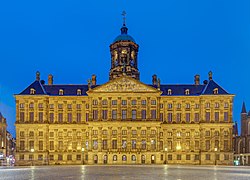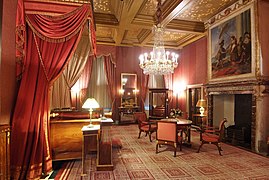
The Rijksmuseum is the national museum of the Netherlands dedicated to Dutch arts and history and is located in Amsterdam. The museum is located at the Museum Square in the borough of Amsterdam South, close to the Van Gogh Museum, the Stedelijk Museum Amsterdam, and the Concertgebouw.

The Kingdom of Holland was the successor state of the Batavian Republic. It was created by Napoleon Bonaparte in March 1806 in order to strengthen control over the Netherlands by replacing the republican government with a monarchy. Since becoming emperor in 1804, Napoleon sought to extirpate republican tendencies in territories France controlled, and placed his third brother, Louis Bonaparte, on the throne of the puppet kingdom. The name of the leading province, Holland, now designated the whole country. In 1807, East Frisia and Jever were added to the kingdom.

Louis Napoléon Bonaparte was a younger brother of Napoleon I, Emperor of the French. He was a monarch in his own right from 1806 to 1810, ruling over the Kingdom of Holland. In that capacity, he was known as Louis I.

In the Netherlands, the Constitution refers to Amsterdam as the capital city. However, the States General and the Executive Branch, along with the Supreme Court and the Council of State, have been situated since 1588 in The Hague as the seat of government. Since the 1983 revision of the Constitution of the Netherlands, Article 32 mentions that "the King shall be sworn in and inaugurated as soon as possible in the capital city, Amsterdam". It is the only reference in the document stating that Amsterdam is the capital. In contrast, The Hague is customarily called the residentie ("residence").

Soestdijk Palace is a palace formerly belonging to the Dutch royal family. It consists of a central block and two wings.

Noordeinde Palace is one of three official palaces of the Dutch royal family. Located in the city center of The Hague in the province of South Holland, it has been used as the official workplace of King Willem-Alexander and Queen Maxima since 2013. The Noordeinde Palace and its surrounding palace grounds are property of the Dutch State.
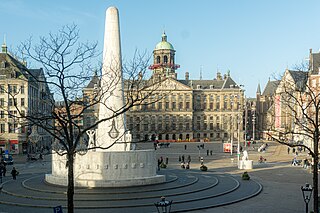
Dam Square or the Dam is a town square in Amsterdam, the capital and most populated city of the Netherlands. Its notable buildings and frequent events make it one of the best-known and most important locations in the city and the country.

Huis ten Bosch is a royal palace in The Hague, Netherlands. It is one of three official residences of the Dutch monarch; the two others being the Noordeinde Palace in The Hague and the Royal Palace in Amsterdam.
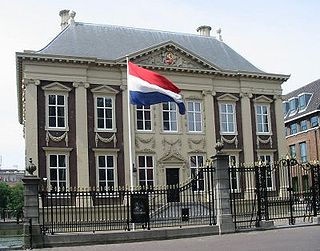
Jacob van Campen was a Dutch artist and architect of the Golden Age.
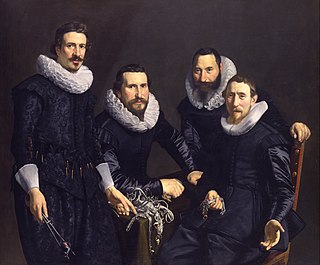
Thomas de Keyser was a Dutch portrait painter and a dealer in Belgium bluestone and stone mason. He was the most in-demand portrait painter in the Netherlands until the 1630s, when Rembrandt eclipsed him in popularity. Rembrandt was influenced by his work, and many of de Keyser's paintings were later falsely attributed to Rembrandt.

The Royal Palace of Brussels is the official palace of the King and Queen of the Belgians in the centre of the nation's capital, Brussels. However, it is not used as a royal residence, as the king and his family live in the Royal Palace of Laeken in northern Brussels. The website of the Belgian Monarchy describes the function of the Royal Palace as follows:
The Royal Palace is where His Majesty the King exercises his prerogatives as Head of State, grants audiences and deals with affairs of state. Apart from the offices of the King and the Queen, the Royal Palace houses the services of the Grand Marshal of the Court, the King's Head of Cabinet, the Head of the King's Military Household and the Intendant of the King's Civil List. The Royal Palace also includes the State Rooms where large receptions are held, as well as the apartments provided for foreign Heads of State during official visits.

Artus Quellinus the Elder, Artus Quellinus I or Artus (Arnoldus) Quellijn was a Flemish sculptor. He is regarded as the most important representative of the Baroque in sculpture in the Southern Netherlands. He worked for a long period in the Dutch Republic and operated large workshops both in Antwerp and Amsterdam. His work had a major influence on the development of sculpture in Northern Europe.

Cornelis de Graeff, often named Polsbroek or de heer van (lord) Polsbroek during his lifetime was an influential regent and burgomaster (mayor) of Amsterdam, statesman and diplomat of Holland and the Republic of the United Netherlands at the height of the Dutch Golden Age.

Corneli(u)s Rudolphus Theodorus, Baron Krayenhoff was a physicist, artist, general, hydraulic engineer, cartographer and – against his will and for only a short time – Dutch Minister of War.

De Graeff is an old Dutch patrician and noble family,
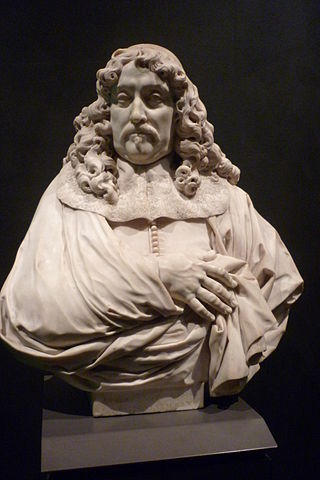
Andries de Graeff was a regent and burgomaster (mayor) of Amsterdam and leading Dutch statesman during the Golden Age.

Jacob de Graeff was a member of the De Graeff-family from the Dutch Golden Age. He was an Amsterdam regent and held the title as 20th Free Lord of Ilpendam and Purmerland.

The Trippenhuis is a neoclassical canal mansion in the centre of Amsterdam. It was built in 1660–1662 for the wealthy Amsterdam weapons traders Louis and Hendrick Trip. Many references to weaponry can be seen on its facade. Since 1887 it has been the seat of the Royal Netherlands Academy of Arts and Sciences (KNAW).

A royal mantle, or more simply a Mantle, is a garment normally worn by emperors, kings or queens as a symbol of authority. When worn at a coronation, such mantles may be referred to as coronation mantles. Many princes also wear such a mantle. Sometimes the mantles are worn only once, but in other instances they may be worn or used on other occasions, such as during the opening of a session of the nation's legislature. Mantles also feature prominently in state portraiture and artwork featuring monarchs and princes.

Katharine "Kay" Dorothy Honor Fremantle, was an English art historian, architectural historian and academic based in the Netherlands.
